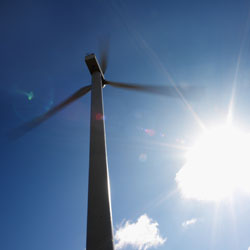 A researcher at Cleveland's Case Western Reserve University (CWRU) has achieved what may be considered a breakthrough in wind turbine blade technology, potentially leading to the development of higher-capacity wind turbines.
A researcher at Cleveland's Case Western Reserve University (CWRU) has achieved what may be considered a breakthrough in wind turbine blade technology, potentially leading to the development of higher-capacity wind turbines.
Marcio Loos, a post-doctoral researcher at the university's Department of Macromolecular Science and Engineering, has built a prototype wind turbine blade that is substantially lighter and eight times tougher and more durable than the materials currently used for wind turbine blades, CWRU says.
Loos worked with colleagues at CWRU and investigators from Bayer MaterialScience in Pittsburgh and Molded Fiber Glass Co. to compare the properties of new materials with the current standards used in blade manufacturing. On his own, Loos built the world's first polyurethane blade reinforced with carbon nanotubes. According to the university, Loos wanted to be sure the composite that was scoring best on the preliminary tests could be molded into the right shape and maintain properties.
Using a small commercial blade as a template, Loos manufactured a 29-inch blade that is substantially lighter, more rigid and tougher.
‘The idea behind all this is the need to develop stronger and lighter materials, which will enable manufacturing of blades for larger rotors,’ he says.
The heavier the blades, the more wind is needed to turn the rotor – which means less energy is captured. And the more the blades flex in the wind, the more they lose the optimal shape for catching moving air, so even less energy is captured. Lighter, stiffer blades enable maximum energy and production.
‘Results of mechanical testing for the carbon nanotube reinforced polyurethane show that this material outperforms the currently used resins for wind blade applications,’ says Ica Manas-Zloczower, professor of macromolecular science and engineering and associate dean at the Case School of Engineering.
In a comparison of reinforcing materials, the researchers found carbon nanotubes are lighter per unit of volume than carbon fiber and aluminum, and had more than five times the tensile strength of carbon fiber and more than 60 times that of aluminum.
Fatigue testing showed the reinforced polyurethane composite lasts about eight times longer than epoxy reinforced with fiberglass. The new material was also about eight times tougher in delamination fracture tests. The performance in each test was even better when compared to vinyl ester reinforced with fiberglass, another material used to make blades. The new composite also has shown fracture growth rates at a fraction of the rates found for traditional epoxy and vinyl ester composites.
Loos and the rest of the team are continuing to test for the optimal conditions for the stable dispersion of nanotubes, the best distribution within the polyurethane and methods to make that happen.
The research is being funded by a U.S. Department of Energy stimulus grant and Bayer MaterialScience.



